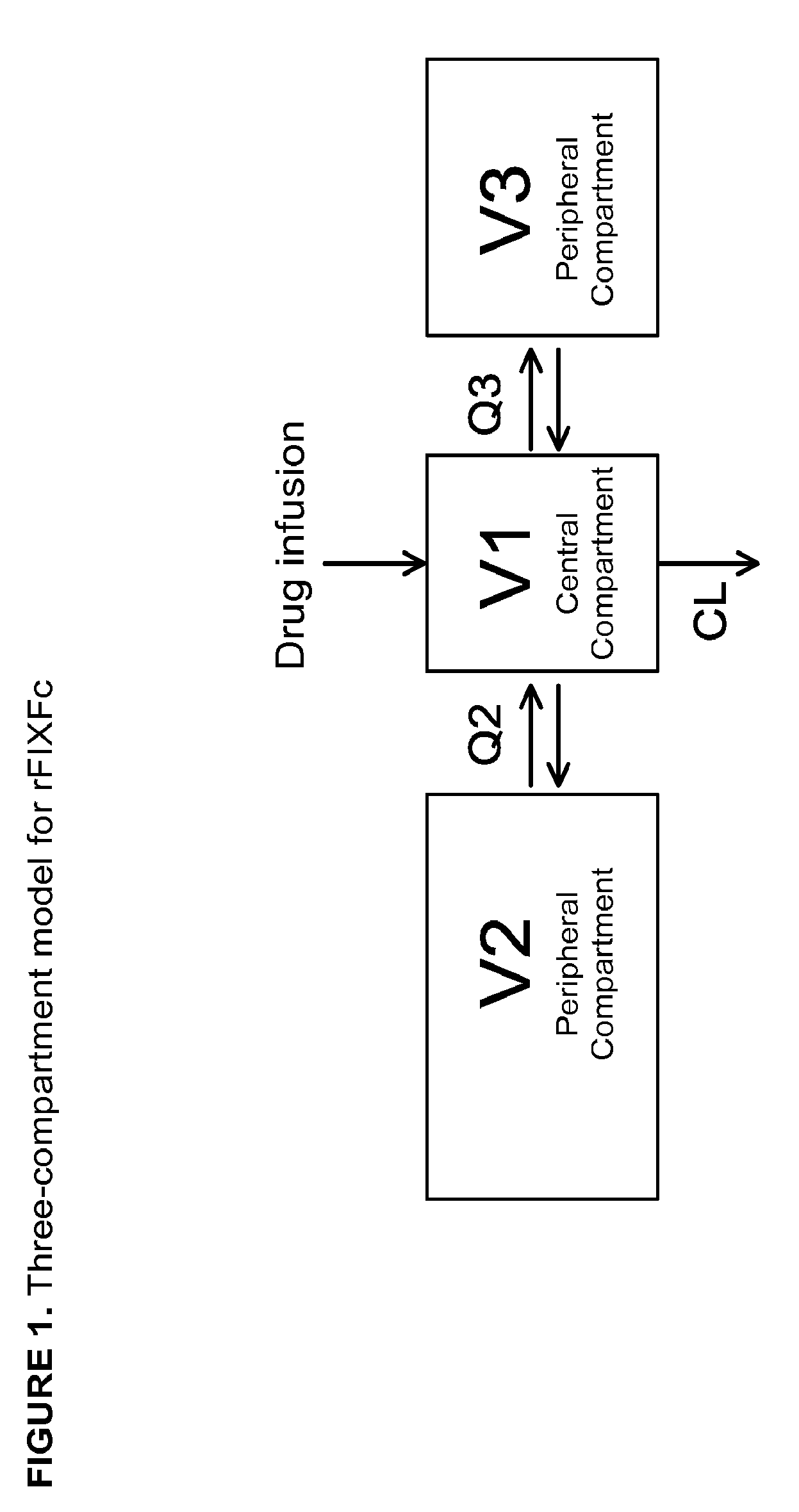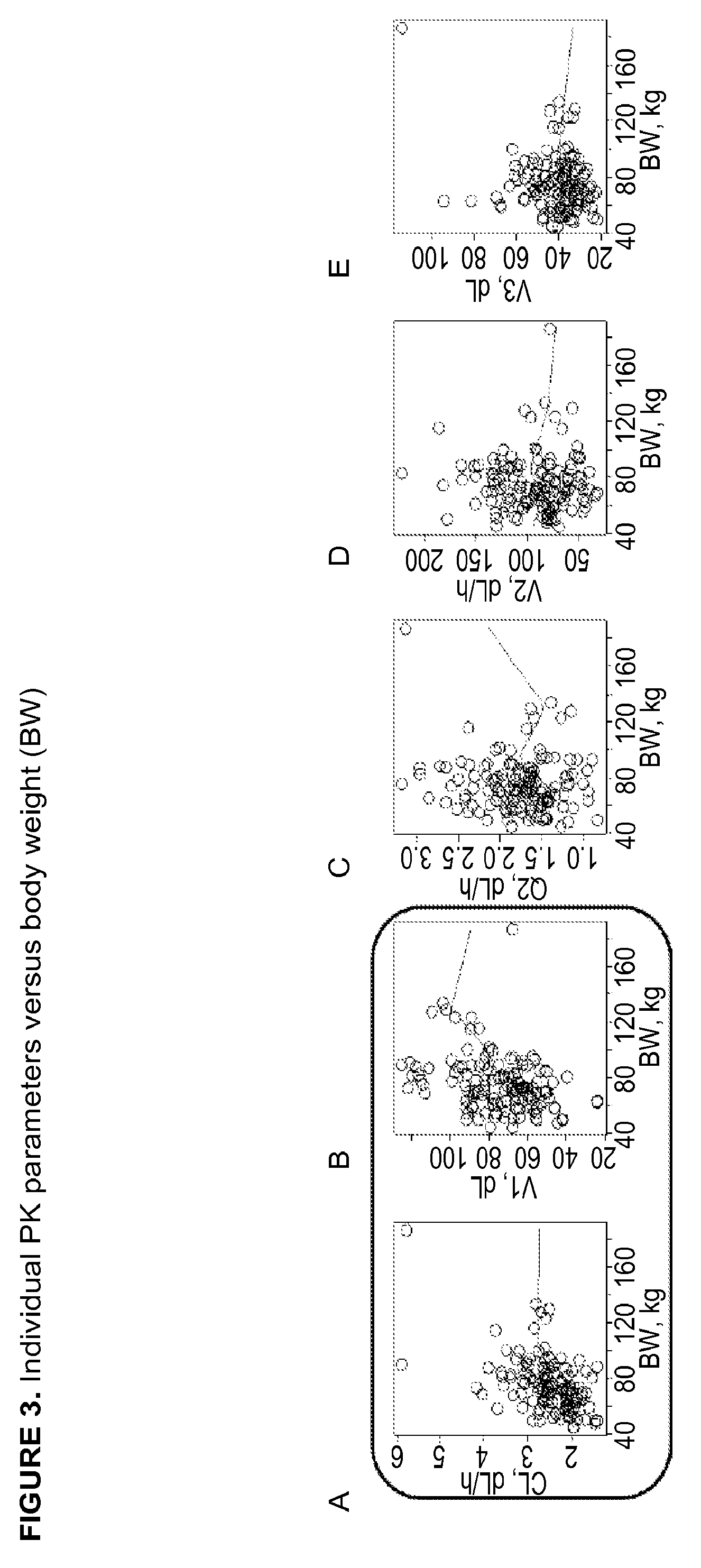Methods of using a fixed dose of a clotting factor
a clotting factor and fixed dose technology, applied in the field of hemostatic disorders, can solve the problems of inconvenient and costly patient administration of clotting factor via body weight-based dosing, and the most expensive and complex conditions to manage, and achieve the effect of reducing, preventing, or reducing one or more symptoms of a bleeding disease or disorder
- Summary
- Abstract
- Description
- Claims
- Application Information
AI Technical Summary
Benefits of technology
Problems solved by technology
Method used
Image
Examples
example 1
Population Pharmacokinetic Analysis of a Long-Acting Recombinant Factor IX-Fc Fusion Protein (rFIXFc) in Patients with Severe Hemophilia B
[0190]BACKGROUND: Population pharmacokinetic (popPK) models are developed to understand the sources of variability in dose requirements (covariates) and to help individualize dosing regimens if necessary. Dosing histories and patient-specific data are used to gain an understanding of drug disposition in order to discern specific demographic and / or clinical factors that may be predictors of PK parameters. By characterizing the population PK of long-acting FIX-Fc (rFIXFc) in patients with severe hemophilia B (≦2 IU / dL plasma FIX activity), a model of estimated population PK parameters of rFIXFc can be established. This model may assist physicians who wish to tailor dosing for individual patients with sparse PK samples. This model may also help determine the suitability of rFIXFc for a fixed dosing regimen.
[0191]METHODS: Male subjects with severe hem...
example 2
Fixed Dosing
[0209]The body weight of adult patients has a limited impact on PK variability among patients. Therefore, rFIXFc is suitable for fixed dosing regimens that do not use the formula:
Number of factor FIX IU required (IU)=Body Weight (kg)×Desired Factor FIX Increase (IU / dL or % of normal)×0.5(IU / kg per IU / dL).
[0210]In this example, fixed dose regimens are established using vials of rFIXFc that contain 2,000 IU per vial. In one alternative, the entire population of adult patients is treated with 2 vials of rFIXFc once weekly. Alternatively, stratified fixed dosing is applied based on the BW range in which the patient belongs to.
[0211]METHODS: Patients with hemophilia B are categorized into one of three categories: (i) low body weight; (ii) normal body weight; and (iii) high body weight. Patients weighing less than 57 kg are categorized as low body weight. Patients weighing between 57 and 104 kg are categorized as normal body weight. Patients weighing more than 104 kg are categ...
example 3
Population Pharmacokinetic Analysis of a Long-Acting Recombinant Factor VIII-Fc Fusion Protein (rFVIIIFc) in Patients with Severe Hemophilia A
[0214]By characterizing the population PK of long-acting FVIII-Fc (rFVIIIFc) in patients with severe hemophilia A, a model of estimated population PK parameters of rFVIIIFc can be established. This model may assist physicians who wish to tailor dosing for individual patients with sparse PK samples. This model may also help determine the suitability of rFVIIIFc for a fixed dosing regimen.
[0215]Objectives: To characterize the activity-time profiles of rFVIIIFc in hemophilia A patients by population PK analysis and to identify intrinsic covariates that may affect the variability of rFVIIIFc PK.
[0216]The modeling dataset included activity-time profiles of 180 subjects (15 from a Phase 1 / 2a study and 165 from a Phase 3 study [A-LONG], collected over ≦52 weeks of treatment). Subjects were 12 to 65 years old and weighed 41-132 kg. The analysis was do...
PUM
| Property | Measurement | Unit |
|---|---|---|
| weights | aaaaa | aaaaa |
| weight | aaaaa | aaaaa |
| size | aaaaa | aaaaa |
Abstract
Description
Claims
Application Information
 Login to View More
Login to View More - R&D
- Intellectual Property
- Life Sciences
- Materials
- Tech Scout
- Unparalleled Data Quality
- Higher Quality Content
- 60% Fewer Hallucinations
Browse by: Latest US Patents, China's latest patents, Technical Efficacy Thesaurus, Application Domain, Technology Topic, Popular Technical Reports.
© 2025 PatSnap. All rights reserved.Legal|Privacy policy|Modern Slavery Act Transparency Statement|Sitemap|About US| Contact US: help@patsnap.com



